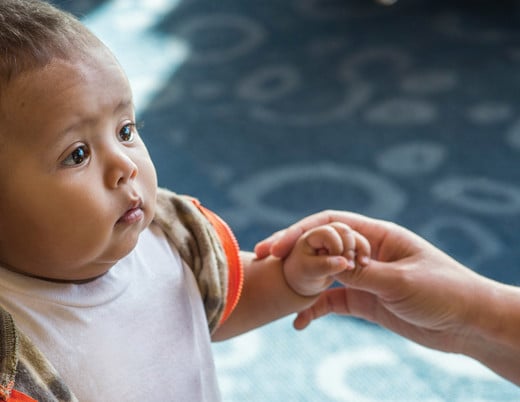Key takeaways
-
This study found that applying accepted use criteria decreases harnessing in Graf IIa hips.
-
Most infants with Graf IIa hips could be observed with ultrasound follow-up.
-
Unstable or dysplastic Graf IIa hips should receive more immediate treatment.
Parameters for developmental dysplasia of the hip treatment in infants
Developmental dysplasia of the hip is a common pediatric developmental orthopedic condition. While universal screening of newborns is not currently recommended, it is recommended that newborns with certain risk factors be screened by diagnostic ultrasound.
Alpha angle and percent femoral head coverage are the two parameters often used to describe hips on ultrasound. Graf classification describes acetabular development with alpha angle as the intersection of lines drawn along the pelvis superior to the acetabulum and along the bony roof of the acetabulum. Femoral head percentage is the ratio of acetabular depth to the diameter of the femoral head.
This study involved a multidisciplinary team within the Children’s Hospital Colorado Orthopedics Institute and the University of Colorado School of Medicine Department of Orthopedics. Study authors included: Margaret S. Murphy-Zane, MD; Patrick M. Carry, PhD; Nancy Hadley Miller, MD; Matthew Belton, MD; Brian Kohuth, PA-C; Deborah Burke, PA-C; Gaia Georgopoulos, MD; Tyler Freeman, MD; and Reba Salton, BS.
The Orthopedics Institute characterizes normal hips in protocols to develop hip dysplasia treatment as:
- Alpha angle ≥ 60 degrees (Graf I)
- Femoral head coverage ≥ 50%
Regardless of age, the Institute’s protocol is to begin Pavlik harness with Graf IIc hips or worse (alpha angle ≤ 49 degrees), or if clinically unstable. Infants under 12 weeks old with Graf IIa were observed and recommended for ultrasound follow-up at 12 weeks old. The majority of hips resolve without intervention, and some practitioners treat with the harness when femoral head coverage is < 50%.
Although the American Academy of Orthopaedic Surgeons released “Appropriate Use Criteria (AUC) for the Management of Developmental Dysplasia of the Hips in Infants up to 6 Months of Age” in 2018, study authors hypothesized that some practitioners at Children’s Hospital Colorado were cautiously treating some hips more often than the guidelines would suggest.
Guidelines from the AUC:
- Hip classification:
- Normal: alpha angle ≥ 60 degrees and femoral head coverage ≥ 45%
- Borderline: alpha angle 50-59 degrees or femoral head coverage 35%-44%; all Graph IIa hips included
- Dysplastic: alpha angle < 50 degrees or femoral head coverage < 35%
- Immediate or delayed brace treatment for neonatal hips (2 to 9 weeks of age) with positive instability exam supported by AUC
Comparing outcomes between Graf IIa hips with and without Pavlik treatment
All patients referred for evaluation of developmental hip dysplasia at Children’s Colorado from 2009 to 2018 were identified for study inclusion. After exclusions, 371 Graf IIa hips (267 patients) were included in the final retrospective study.
Study authors obtained initial and 6-month follow-up ultrasound data including percent femoral head coverage and acetabular alpha angle measurements. They then grouped the hips by AUC severity.
- Stable hips with femoral head coverage ≥ 35 degrees, in borderline and normal categories, grouped as stable, nondysplastic Graf IIa hips
- Unstable hips defined as positive Barlow and/or Ortolani test
Pavlik harness treatment decreased 67% when Accepted Use Criteria applied
Among the 371 hips included in the study analysis:
- 250 Graf IIa hips treated with Pavlik harness
- 6 Graf IIa hips treated with Rhino brace
- 89 (24%) of all included hips clinically unstable and 37 also dysplastic
- 282 Graf IIa hips stable and 12 dysplastic
Hips were then divided by the AUC definitions of dysplastic or normal for evaluation:
- 49 (13%) of Graf IIa hips considered dysplastic
- 270 stable hips considered normal or borderline femoral head coverage
- Group 1 (normal): femoral head coverage > 45%
- Group 2 (borderline): femoral head coverage 35-44%
- Group 1 and 2 combined to create a stable non-dysplastic hip group
An evaluation of reasons for treatment of 158 stable non-dysplastic Graf IIa hips found:
- 52 (33%) treated in Pavlik harness due to more severe contralateral hip
- Contralateral hips not included in study
- If AUC was applied, 106 hips would not have been treated
- 67% reduction in stable non-dysplastic Graf IIa hips treated at Children’s Colorado
Study authors evaluated if delays in treating stable non-dysplastic hips would lead to poorer outcomes by comparing acetabular indices on 6-month pelvis X-rays in treated and untreated stable non-dysplastic hips (per AUC, both should not have been treated).
- 162 hips returned for 6-month radiograph
- 84 days median duration of treatment for all stable non-dysplastic hips
After adjusting for age, sex and laterality (bilateral vs. unilateral developmental dysplasia of the hip) at 6-month visit:
- Untreated hips had higher acetabular index values at 6 months
- Mean difference −1.5, 95% CI, −3.1 to 0.2, P= 0.0808
- Untreated hips had lower alpha angle values at 6 months
- Mean difference 1.6, 95% CI, −0.2 to 3.3, P =0.0834
- Incidence of developmental hip dysplasia (after adjusting for age and sex at 6-month visit):
- 3% among treated hips
- 5% among untreated hips
- Odds of treatment failure among treated hips were 0.5 times the odds of treatment failure among untreated hips
Observation and a follow-up ultrasound for most stable Graf IIa hips could be sufficient
The authors noted 73% of the Graf IIa hips studied were stable non-dysplastic using the AUC parameters and may do well with observation and a follow-up ultrasound around 12 weeks old.

- Only 6 of 270 stable hips analyzed did not normalize by the 12-week follow-up
- Progressed to Graf IIb
- Underwent bracing
- Applying the AUC parameters for femoral head coverage would reduce the number of stable non-dysplastic Graf IIa hips treated at Children’s Colorado by 67%
- 24% of Graf IIa hips were clinically unstable
- Children’s Colorado and AUC agree that unstable hips should be treated, especially if persist past perinatal period
- All were treated
- 13% Graf IIa hips dysplastic
- 96% treated, in line with AUC recommendation
- 27% Graf IIa should be treated
- 12 for femoral head coverage < 35%
- 52 for instability
- 37 for both
Study authors found there is practice variability throughout the Children’s Colorado system, despite the established protocol for infant hip dysplasia. This identified the need for a better definition of what constitutes pathologic femoral head coverage.
Key findings:
- Stable Graf IIa hips with femoral head coverage ≥ 35 degrees do not benefit from Pavlik harness treatment.
- Most Graf IIa hips considered borderline using AUC criteria should initially be observed before bracing.
The study concluded with a caution about Graf IIa hips:
- 24% are clinically unstable
- 13% have femoral head coverage < 35% (dysplastic per the AUC)
- Both warrant more immediate treatment
Featured researchers

Margaret Siobhan Murphy-Zane, MD
Orthopedic surgeon
The Orthopedics Institute
Children’s Hospital Colorado
Associate professor of clinical practice
Orthopedics
University of Colorado School of Medicine
Patrick Carry, MS, PhD
Assistant professor
Orthopedics
University of Colorado School of Medicine

Nancy Hadley-Miller, MD
Orthopedic Surgery
Children’s Hospital Colorado
Professor
Orthopedics
University of Colorado School of Medicine

Brian Kohuth, PA-C
Certified physician assistant
The Orthopedics Institute
Children's Hospital Colorado
Instructor
Orthopedics
University of Colorado School of Medicine

Debbie Burke, PA-C
Physician assistant
The Orthopedics Institute
Children’s Hospital Colorado
Instructor
Orthopedics
University of Colorado School of Medicine

Gaia Georgopoulos, MD
Orthopedic surgeon
The Orthopedics Institute
Children’s Hospital Colorado
Associate professor
Orthopedics
University of Colorado School of Medicine





 720-777-0123
720-777-0123










